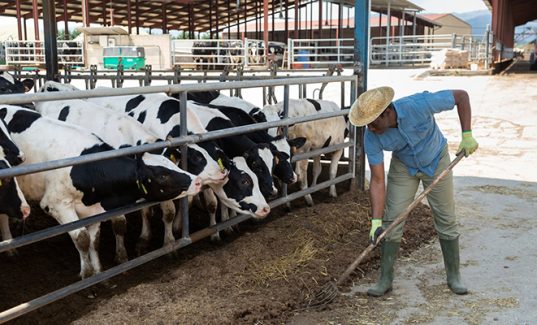Composting is becoming a hot topic in the south-west Western Australia and it’s giving dairyfarmers a lot to ponder. Their farms produce most of the inputs required to make compost, and most farmers have a real desire to use their waste effectively. So in some ways it seems like a natural fit. The question is, how effective is compost on dairy farms and do the benefits outweigh the costs?
Western Dairy is attempting to address these questions in a new project supported by the South West Catchments Council. It held a field day recently and invited Dairy Australia’s Graeme. Ward and University of Western Australia’s Professor Lyn Abbott to discuss the potential for compost in dairy systems.
Mr Ward said that composting was a good use of farm waste, but it could take some time for the nutrients to become plant-available.
“At first sight the compost being used in the Western Dairy project looks to be a good source of nutrients, but much of it is organically bound, ” he said. “For example, you would only expect about 10 per cent of the nitrogen to be mineralized and made available to plants in the first year. Phosphorus and potassium are more available, but you would still need to apply large rates to be an effective source.”
While the slow-release nature of compost can be positive in preventing nutrient loss, particularly for potassium on leachable soils, it struggles to match synthetic fertilisers as an efficient strategy to meet the agronomic requirements of high-performance dairy pastures. And while it can be a source of soil organic carbon, most well-managed dairy pastures already have healthy and stable levels of soil carbon. But according to Professor Abbott, who is working with Western Dairy to identify how compost can benefit soil biology, the positive effects of compost might be more complex.
“If we can build up microbial communities with compost, they can become a source of nitrogen, phosphorus, potassium and sulphur,” she said. “They add a dynamism into the system that we don’t yet understand or capture with traditional soil tests.”
Professor Abbott said researchers were only starting to look into how compost influenced microbes and the impact of this. “It’s only been in the last couple of years that we have developed the tools that can help understand these interactions,” she said. It’s these ‘unknowns’ that motivate farmers to give compost a try, particularly on problem paddocks. Dardanup, WA, dairyfarmer Matt Brett, who hosted the field day event, said that his primary motivation was to turn his waste into a better product. However, he is also hoping that the microbes have a few tricks up their sleeve.
“We irrigate with salty water over summer, which is tough on pastures,” Mr Brett said. “Promoting soil biology might help us improve that problem.” And, like most farmers trialling compost, Mr Brett isn’t looking to replace synthetic fertilizers. He just wants to see if compost can improve the efficiency of synthetics and perhaps allow him to eventually reduce his inputs. Mr Ward also had some timely advice for farmers about the potential risk of adverse outcomes from poorly made compost or products that contain impurities.
“There is a push to recycle industrial and green waste to reduce landfill, and this has created a lot of interest in compost,” he said. “So there are a lot of products coming on to the market all with different properties.” Farmers interested in purchasing compost are strongly encouraged to seek reputable suppliers and to ask for product specification and quality assurance. “We need to be on the lookout for impurities like heavy metals, soluble salts, weeds, pathogens and herbicide residues, and monitor to see if these build up over time,” Mr Ward said.
The Western Dairy Compost project is due for completion in 2017.
Source: Australian Dairy Farmer




